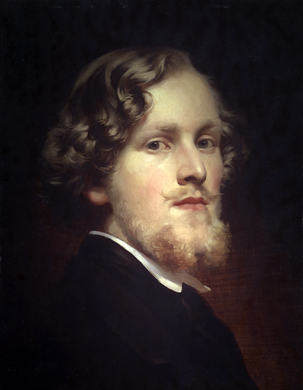A Brief Biography of J.M.F. Heinrich Hofmann
by Angela Swanson Jones
 Self-Portrait, c. 1850, Oil on Paper Institut Mathildenhöhe / Darmstadt Municipal Art Collection
Self-Portrait, c. 1850, Oil on Paper Institut Mathildenhöhe / Darmstadt Municipal Art Collection
Johann Michael Ferdinand Heinrich Hofmann was born in Darmstadt, Germany to parents who always encouraged his enthusiasm for art. His mother tutored all of her five sons in drawing, but it was Heinrich who showed the greatest talent and consequently “He always declared he would be a painter and nothing else.” Hofmann’s formal training began when he was 16 through an apprenticeship with the copper engraver Ernest Rauch. In 1842 he entered the Düsseldorf Academy, which was “the leading German academy,” and an advocate of religious painting, well into the nineteenth century. During Hofmann’s three years at Düsseldorf he displayed precocious talent eventually earning him a place in the top master class under the direction of the influential Nazarene, Wilhelm von Schadow. Hofmann then spent the next twelve years visiting and studying in Europe’s major art centers: Antwerp, Paris, Munich, Dresden, Prague, and most importantly Rome where he lived and painted for nearly three years. During these years he developed an idealized, academic style, which was informed by a study of the old masters.
Hofmann was not solely a religious painter. He found success in many other genres including German history, Shakespeare and mythology. However, it was portrait commissions that dominated his oeuvre for decades. Although portraiture filled him “in the long run with such emptiness and fatigue”, it was necessary to support himself, his ill wife and the numerous charitable causes to which they generously contributed.
Hofmann will always be remembered foremost as a religious painter. It is the genre that won him his greatest success, and brought his deeply spiritual mind the most satisfaction. His first museum purchased painting was The Capture of Christ (1858). The Adulteress before Christ (1868) won him membership in the Dresden Art Academy where subsequently he taught for over twenty years. Other notable paintings include Jesus in the Temple (1880-81), Christ and the Rich Young Ruler (1888/89), Christ in Gethsemane (1890) and Portrait of Christ, the Savior (1894). He also produced three major portfolios of drawings depicting scenes from the life of the Savior. These were portfolios were published and widely distributed in Europe and America. His interest in Christian art grew out of his own faith in the New Testament. One writer noted that, “It is vouched of Heinrich Hofmann, that he began each day and closed it by reading in the Holy Scriptures, in which he was at home.” Ironically, religious painting didn’t become his main focus until the 1880s just as production of Christian art began to wane in Continental Europe.
Hofmann’s religious painting found great appreciation among Americans, which accounts for many of his best works being in United States, saving them from the devastation of World-War II that claimed so many of Hofmann’s works. By the time of his death his paintings were deemed “old-fashioned”. Eventually, Heinrich Hofmann’s surviving art was assigned to museum vaults or the collector’s attics, and forgotten. Only in Christian homes and churches have his paintings and prints been cherished and displayed proudly.
Hofmann was not solely a religious painter. He found success in many other genres including German history, Shakespeare and mythology. However, it was portrait commissions that dominated his oeuvre for decades. Although portraiture filled him “in the long run with such emptiness and fatigue”, it was necessary to support himself, his ill wife and the numerous charitable causes to which they generously contributed.
Hofmann will always be remembered foremost as a religious painter. It is the genre that won him his greatest success, and brought his deeply spiritual mind the most satisfaction. His first museum purchased painting was The Capture of Christ (1858). The Adulteress before Christ (1868) won him membership in the Dresden Art Academy where subsequently he taught for over twenty years. Other notable paintings include Jesus in the Temple (1880-81), Christ and the Rich Young Ruler (1888/89), Christ in Gethsemane (1890) and Portrait of Christ, the Savior (1894). He also produced three major portfolios of drawings depicting scenes from the life of the Savior. These were portfolios were published and widely distributed in Europe and America. His interest in Christian art grew out of his own faith in the New Testament. One writer noted that, “It is vouched of Heinrich Hofmann, that he began each day and closed it by reading in the Holy Scriptures, in which he was at home.” Ironically, religious painting didn’t become his main focus until the 1880s just as production of Christian art began to wane in Continental Europe.
Hofmann’s religious painting found great appreciation among Americans, which accounts for many of his best works being in United States, saving them from the devastation of World-War II that claimed so many of Hofmann’s works. By the time of his death his paintings were deemed “old-fashioned”. Eventually, Heinrich Hofmann’s surviving art was assigned to museum vaults or the collector’s attics, and forgotten. Only in Christian homes and churches have his paintings and prints been cherished and displayed proudly.
